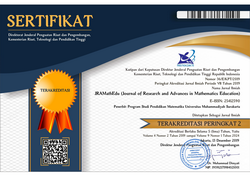A Secondary Student’s Problem Solving Ability in Learning Based on Realistic Mathematics with Ethnomathematics
Farida Nursyahidah(1*), Bagus Ardi Saputro(2), Maya Rini Rubowo(3)(1) Universitas PGRI Semarang
(2) Universitas PGRI Semarang
(3) Universitas PGRI Semarang
(*) Corresponding Author
Abstract
Keywords
Full Text:
PDFReferences
Ascher, M. (1991). Ethnomathematics: A Multicultural View of Mathematics Ideas. New York: Capman & Hall.
D’Ambrosio, U. (1985). Ethnomathematics and Its Place in the History and Pedagogy of Mathematics. Tersedia pada http://www.math.utep.edu/Faculty/pmdelgado2/Math1319/History/D’AmbrOsio.pdf.
Donaldson, S.E. (2011). Teaching through Problem Solving: Practices of Four High School Mathematics Teachers. Unpublised Dissertation. Athens: The University of Georgia.
Fauziah, A. (2010). Peningkatan Kemampuan Pemahaman dan Pemecahan Masalah MatematikaSiswa SMP melalui Strategi REACT (Relating, Experiencing, Applying, Cooperating, Transfering). Bandung: Tesis UPI tidak diterbitkan.
Gravemeijer, K. (1994). Developing Realistic Mathematics Education. Utrecht: Technipress, Culemborg.
Grouws, D. A. (1985). The teacher and classroom instruction: Neglected themes in problem-solving research. In E. Silver (Ed.), Teaching and learning mathematical problem solving: Multiple research perspectives. Hillsdale, NJ: Lawrence Erlbaum.
Kahan, J. A., & Wyberg, T. R. (2003). Mathematics as sense making. In H. L. Schoen (Ed.), Teaching mathematics through problem solving: Grades 6–12 (pp. 15–25). Reston, VA: National Council of Teachers of Mathematics.
Lambdin, D. V. (2003). Benefits of teaching through problem solving. In F. K. Lester (Ed.), Teaching mathematical through problem solving: Prekindergarten–Grade 6 (pp. 3–13). Reston, VA: National Council of Teachers of Mathematics.
Lange, J. de (1996). Using and Applying Mathematics in Education. In: A.J. Bishop, et al. (eds). 1996. International handbook of Mathematics Education, Part one. 49-97. Kluwer academic publisher.
Lester, F. K. (1994). Musings about mathematical problem-solving research: 1970-1994. Journal for Research in Mathematics Education, 25(6), pp. 660-675.
Lester, F. K., Jr., & Charles, R. (Eds.). (2003). Teaching mathematics through problem solving: Prekindergarten–Grade 6. Reston, VA: National Council of Teachers of Mathematics.
Levasseur, K., & Cuoco, A. (2003) Mathematical habits of mind. In H. L. Schoen (Ed.), Teaching mathematics through problem solving: Grades 6–12 (pp. 27–37). Reston, VA: National Council of Teachers of Mathematics.
McCaffrey, D. F., Hamilton, L. S., Stecher, B. M., Klein, S. P., Bugliari, D., & Robyn, A. (2001). Interactions among instructional practices, curriculum, and student achievement: The case of standards-based high school mathematics. Journal for Research in Mathematics Education, 32(5), pp. 493-517.
Nasution, S. (2010). Berbagai Pendekatan Dalam Proses Belajar Mengajar. Jakarta: PT Bumi Aksara.
National Council of Supervisors of Mathematics. (1989). Essential mathematics for the twenty-first century: The position of the National Council of Supervisors of Mathematics. Mathematics Teacher, 81(1), 16-21.
National Council of Teachers of Mathematics. (1980). Problem solving in school mathematics: 1980 yearbook (S. Krulik and R. E. Reys, Eds.). Reston, VA: NCTM.
National Council of Teachers of Mathematics. (1989). Curriculum and evaluation standards for school mathematics. Reston, VA: NCTM.
National Council of Teachers of Mathematics. (2000). Principles and standards for school mathematics. Reston, VA: NCTM.
Nursyahidah, F. (2013). Supporting First Grade Students’ Understanding of Addition up to 20 Using Traditional Game. IndoMS. J.M.E. Vol. 4 No. 2 July 2013, pp. 212-223.
Polya, G. (1945). How to solve it. Princeton, NJ: Princeton University Press.
Polya, G. (1973). How to Solve It (New of Mathematical Method). Second Edition. New Jersey: Prence University Press.
Prabawati, M.N. (2016). Etnomatematika Masyarakat Pengrajin Anyaman Rajapolah Kabupaten Tasikmalaya. Jurnal Infinity. Vol. 5 No. 1 Fabruari 2016.
Puspadewi, K. R. & Putra, N. N. (2014). Etnomatematika di Balik Kerajinan Anyaman Bali. Jurnal Matematika. Vol. 4 No. 2 Desember 2014. ISSN: 1693-1394.
Redhana, I.W. (2013). Model Pembelajaran Berbasis Masalah untuk Peningkatan Keterampilan Pemecahan Masalah dan Berpikir Kritis. Jurnal Pendidikan dan Pengajaran. Jilid 46 No. 1, Hal 76-86.
Reid, D. A. (2002). Conjectures and refutations in grade 5 mathematics. Journal for Research in Mathematics Education, 33(1), pp. 5-29.
Schoen, H. L. (Ed.). (2003). Teaching mathematics through problem solving: Grades 6–12. Reston, VA: National Council of Teachers of Mathematics.
Silver, E. A. (1985). Research on teaching mathematical problem solving: Some underrepresented themes and needed directions. In E. Silver (Ed.), Teaching and learning mathematical problem solving: Multiple research perspectives. Hillsdale, NJ: Lawrence Erlbaum.
Sugiyono. (2008). Memahami Penelitian Kualitatif. Bandung: Alfabeta.
Suroto. (2011). Upaya Meningkatkan Hasil Belajar Matematika Siswa Kelas VIIF SMP 2 Semarang melalui Penerapan Pengajuan Masalah pada Materi Bangun Datar Tahun Pelajaran 2010/2011. Jurnal Sains dan Matematika 1: 319-398.
Treffers, A. (1991). Realistic Mathematics Education in The Netherlands 1980-1990. In L. Streefland (ed.) Realistic Mathematics Education in Primary School. Utrecht: CD-b Press/Freudenthal Institute, Utrecht University.
Ubayanti, C. S., Happy, L., & Mayor, M.H.M. (2016). Eksplorasi Etnomatematika pada Sero (SET NET): Budaya Masyarakat Kokas Fakfak Papua Barat. Jurnal Ilmiah Matematika dan Pembelajarannya. Vol. 2 No. 1.
Wijaya, A. (2012). Pendidikan Matematika Realistik: Suatu Alternatif Pendekatan Pembelajaran Matematika. Graha Ilmu: Yogyakarta.
Wilson, J. W., Fernandez, M. L., & Hadaway, N. (1993). Mathematical problem solving. In P. S. Wilson (Ed.), Research ideas for the classroom: High school mathematics (pp. 57–78). New York, NY: Macmillan.
Article Metrics
Abstract view(s): 1919 time(s)PDF: 2166 time(s)
Refbacks
- There are currently no refbacks.








